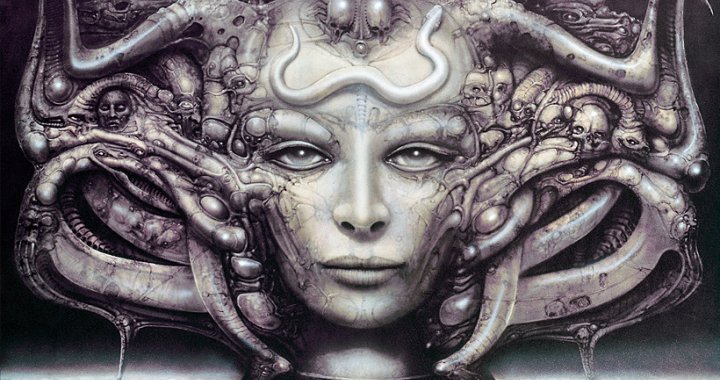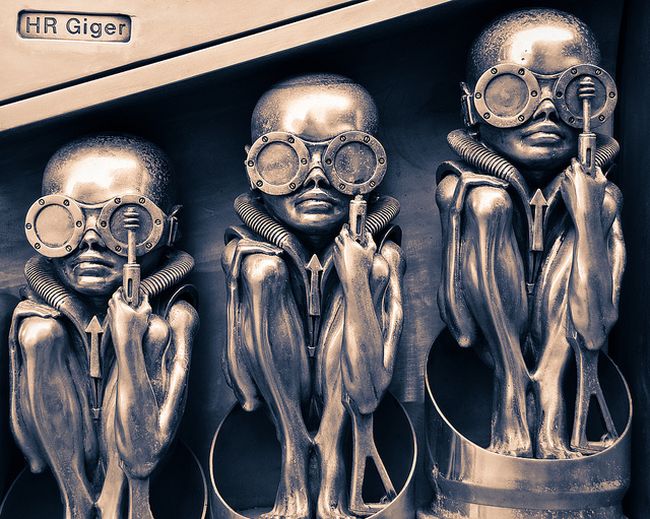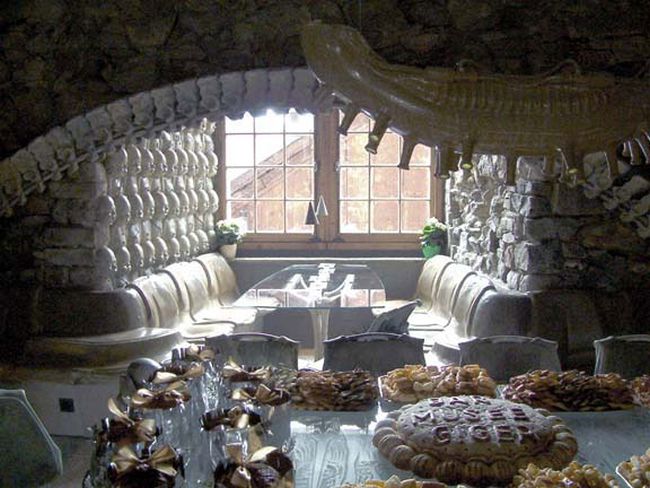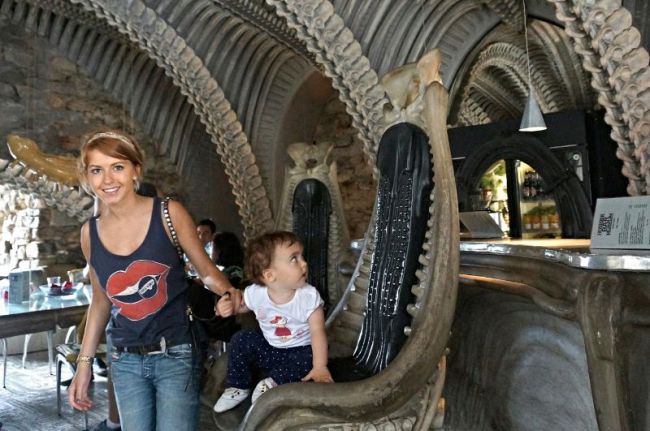
Giger’s Biomechanical Wonderland
30/07/2014
Hans Rudolf Giger, the Swiss artist and fantasist, died in his home in Zürich on May 12 of this year, at the age of 74. In a letter addressed to the admirers of Giger's work, his family wrote the following words: “His amiable personality, unbelievable generosity and sense of humor sharply contrasted with how the Universe was portrayed in his art.”
Giger was born in 1940, in Chur, Switzerland. In 1970 he graduated from the Division of Interior and Manufacturing Design at the Zurich University of the Arts. Giger's vibrant talent as a visionary had already manifested during his student days, and his obviously masterful skill in painting gained the upper hand over the profession for which he had been educated.

Giger refined the filigree “airbrush” style of freehand painting, which was an obvious asset in the creation of many of his most well-known surrealist works. Most of the paintings that Giger created in this technique are large format, and the scenes depicted are extremely detailed, monochromatic and confusingly terrifying. The so-called “biomechanics” that interlace Giger's works come from a surreal world – a community of non-existent flora and fauna in which living creatures are melded together with industrial forms into one single organism. The hybrids born into this synthesis are naked and cold, but at the same time, strangely captivating. A horde of grotesque body parts, smooth and slimy-looking flesh and metallic mechanics pull the viewer into the depths of these paintings. Giger's sensitive imagination – which often overstepped the boundaries of sodomy and cultism – broke the generally accepted norms of aesthetics.
Giger dared to play with the darkest toy blocks of our imagination: “I paint the things that scare me”, revealed the artist. For many years he suffered from chronic sleep problems; in a certain sense, the act of retreating from the profession of designer and turning towards painting served as a healing form of therapy after his bouts of feverish nightmares.
Up until the last day of his life, Giger always had a sketchbook on the nightstand next to his bed – so that he could spend his sleepless nights drawing images of the demons that had been keeping him company since the 70s.
Giger's “children of the dark” also found a place in pop culture, and in a wide variety of iterations. Giger even worked on creating the set design for Alejandro Jodorowsky's (1929) ambitious, but unsuccessful, remake of “Dune” (1975). During the 70s, Giger also produced the album art for several music groups, including the sleeve covers for “Brain Salad Surgery (1973) – by the UK rock group Emerson, Lake and Palmer, and “To Mega Therion” – by the group Celtic Frost. Debbie Harry, from the legendary group Blondie, completely entrusted the masterful hand of the visionary Giger to create the artistic concept for the music video “Backfired” (1981), as well as the cover for the group's album “KooKoo” (1981). It is worth mentioning that both “Brain Salad Surgery” and “KooKoo” are on the Rock and Roll Hall of Fame's list of 100 Best Album Covers. Giger's decidedly most scandalous album cover – which even ended up in a court of law – was for “Frankenchrist” (1985), by the punk group Dead Kennedys; the cover featured one of Giger's most controversial works, “Penis Landscape” (1973). Giger also designed the mike stand that Jonathan Davis uses during his concerts with his group KoRn.
Shortly after the publication of Giger's lexicon on biomechanics, Necronomicon (1977), there came a turning point in his career as an author. The hefty collection of lithographs found its way into the hands of British film director Ridley Scott (1937), and the rest is cinematic history... Having discovered Giger's works during pre-production for the thriller “Alien” (1979), Scott contracted Giger as the film's creative director – Giger was to develop the visual concept for the film – a film that would go on to be a major block-buster.

Unfortunately, this Hollywood product reached Eastern European audiences only in the 90s, and in the form of a VHS cassette featuring one nasal voice dubbed over all of the film's dialog. An epic saga that takes place in the distant future, the “Alien” science-fiction film series has Sigourney Weaver as its lead. The film's plot: The crew of a drifting space ship finds alien eggs; one of the eggs develops and grows into a horrifying creature that has the ability to destroy humanity. A sexual subtext is clearly visible – the dreadful alien's reproductive system implants the seed of its race into a human body, where it then incubates until it matures and explodes out of its host's chest.
The design of the film's alien was based on the characteristics of a creature pictured in Giger's “Necronom IV” lithograph, and marks a significant distancing from the stereotypical “little-green-men-from-Mars” archetype that had been used in most sci-fi films up to that point. Giger's creature was an androgynous figure with a human-like body and a grotesque, phallic-shaped skull. As the film's creative director, Giger personally developed the alien's image in all of its forms of development – from egg to its impressive “birthing”, and then on to its two-meter-tall adult form. The Ridley Scott-directed science-fiction block-buster “Alien” brought Giger's creative team an Oscar for best visual effects at the 1980 Academy Awards.
Giger's success on the big screen ensured his fame in the USA, and finally, even in Switzerland – where in the 70s, “cultural specialists” had dismissed Giger's work, even rejecting his application for a state stipend for artists.

The Hans Rudolf Giger Museum can be found halfway between Lausanne and Fribourg, in the center of the picturesque, medieval Swiss city of Gruyères. The museum is located in a four-story historical building that Giger bought in 1998, and gives Gruyères – usually best known for its encapsulation in medieval-era fortifications – a completely different and surreal dimension.

The museum's collection is the largest grouping of Giger's works accessible to the public, and contains early works, very recent works, sculptures and design furniture. Somewhere between reality and fiction, between the past and mystical prophesies, two worlds stand in contrast – one is pastoral, while the other is Giger's cosmos. The interior of the museum was set up according to Giger's strict directives, and adheres to the artist's characteristic biomechanical style. The building's windows were securely blacked-out, and the greater part of the gallery rooms have been made intentionally dark. A substantially-sized exhibit is devoted to the subject of “Alien”, the movie. It includes descriptions of the visual effects used in the film, developmental sketches of the alien, and even a working model of the alien's head. Another room, isolated and lit with red lamps, has a sign by its entrance warning that the exhibits within are not suitable for children. Inside are Giger's erotic drawings featuring caricatured sex acts and strings of realistic-looking genitalia. At the end of the retrospective, on the museum's top floor, is Giger's private art collection containing his and his colleagues' favorite artworks, including pieces by Dali, Ernst Fuchs and Dado.

Even though the gallery rooms full of unearthly beings go on one after the other – beginning with abstract phantoms from the past and ending with wayward visitors from the Moon – scaring visitors was not Giger's objective. The figures in his works, including Gorgon-like priestesses engaged in erotic orgies and the Devil himself, look out at the viewer with calm, half-hooded eyes. There's not a smidgen of ambiguity or anxiety to be seen. In Geiger's necro-gothic world, the spiritual physiognomy of the subjects is in perfect harmony with the lifeblood with which he has bestowed them.

In 1992, one of Giger's long-fostered projects celebrated its grand opening – the first authentic HR Giger Bar, in Giger's hometown of Chur, Switzerland. A second bar was opened in 2003 – The Museum HR Giger Bar – located right across the street from the museum located in romantic Gruyères. The two bars' ceilings, walls, floors and furnishings were designed under Giger's close supervision, following his original concept to a tee. Both design-bars feature the same biomechanical style, but there are some nuanced differences: the Chur bar is black and metallic in tone, while the Gruyères bar – which has the exact same architectural design – has been done up in the shade of weathered bone. The choice of color in this last bar harmonizes with the architecture of the region's 400-year-old Gothic structures. Huge skeletal arcs swathe over the vaulted ceilings which, together with the furniture designed by Giger, emphasize the building's original medieval character and create a strange, church-like ambiance. The bars' chairs – with pelvic-bone headrests – have become symbols of the HR Giger Bar brand-name, and are based on prototypes for the throne of House Harkonnen in the Alejandro Jodorowsky-directed film, “Dune”.
 Elīna Ije and Azzuri at the Museum HR Giger Bar, Gruyères
Elīna Ije and Azzuri at the Museum HR Giger Bar, Gruyères
Largely forgotten is Giger's most ambitious project for a bar in Tokyo. During a press conference in Japan, Giger was asked to state a wish of his, to which he replied – a bar created in the biomechanical style. This spontaneous answer led to an explosion of creative brainstorming. Giger worked out a plan for a bar of the likes never seen before – intimate booths, with a table for two, that would function as a see-through elevator continually moving up and down a height of four floors. Such a structure, it turned out, was not allowed under Japan's building code – due to the region's risk of earthquakes – and the plans had to be reworked. The Japanese backers of the bar, however, did not wait for Giger's final reworking, and went ahead with construction based on just the artist's provisional sketches. The bar was built underground, which was in complete contradiction to Giger's intentions. For this reason, and not only, Giger refused any association with the Tokyo HR Giger Bar and never set foot inside of it. Once, out of curiosity, a friend of Giger's went to have a look at the Tokyo establishment. It seems that he was the only customer until 11:00 PM, after which the place filled with questionable characters who then proceeded to set up a roulette table in the atrium. Sometime over the next five years, the bar closed down.
This year the Sci-Fi Hotel chain announced that they will be creating the same kind of Giger concept-bars in the USA – in Seattle and New York City.